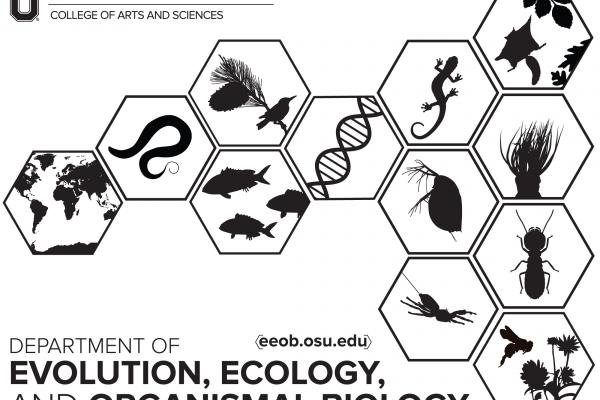July 24, 2017
Publications by EEOB faculty July 1 - July 31

Demographic Model Selection using Random Forests and the Site Frequency Spectrum
Megan L. Smith, Megan Ruffley, Anahí Espíndola, David C. Tank, Jack Sullivan, Bryan C. Carstens. 2017. Mol Ecol. Accepted Author Manuscript. doi:10.1111/mec.14223
Abstract
Phylogeographic datasets have grown from tens to thousands of loci in recent years, but extant statistical methods do not take full advantage of these large datasets. For example, Approximate Bayesian Computation (ABC) is a commonly used method for the explicit comparison of alternate demographic histories, but it is limited by the ‘curse of dimensionality’ and issues related to the simulation and summarization of data when applied to next-generation sequencing (NGS) datasets. We implement here several improvements to overcome these difficulties. We use a Random Forest (RF) classifier for model selection to circumvent the curse of dimensionality and apply a binned representation of the multidimensional site frequency spectrum (mSFS) to address issues related to the simulation and summarization of large SNP datasets. We evaluate the performance of these improvements using simulation and find low overall error rates (~ 7%). We then apply the approach to data from Haplotrema vancouverense, a land snail endemic to the Pacific Northwest of North America. Fifteen demographic models were compared, and our results support a model of recent dispersal from coastal to inland rainforests. Our results demonstrate that binning is an effective strategy for the construction of a mSFS and imply that the statistical power of RF when applied to demographic model selection is at least comparable to traditional ABC algorithms. Importantly, by combining these strategies, large sets of models with differing numbers of populations can be evaluated.
High levels of gene flow among song dialect populations of the Puget Sound white-crowned sparrow
Angelika Poesel, Anthony C. Fries, Lisa Miller, H. Lisle Gibbs, Jill A. Soha, Douglas A. Nelson. 2017. Ethology.00:1–12. https://doi.org/10.1111/eth.12632
Abstract
Populations within a species can show geographic variation in behavioral traits that affect mating decisions or limit dispersal. This may lead to restricted gene flow, resulting in a correlation between behavioral variation and genetic differentiation. Populations of a songbird that differ in a learned behavioral trait, their song dialects, may also differ genetically. If song dialects function as mating barriers, evolutionary processes such as genetic drift should lead to divergence in allele frequencies among dialect populations. The Puget Sound white-crowned sparrow (Zonotrichia leucophrys pugetensis) is an excellent study system with a well-defined series of song dialects along the Pacific Northwest coast. A previous study found low genetic differentiation based on four microsatellite loci; however, available loci and analyses techniques have since dramatically improved and allow us to reassess gene flow in this species. We also add extra samples to fill in gaps and add a new level of analysis of geographic variation. Based on acoustic similarities, we group six song dialects into two geographically larger “northern” and “southern” song themes. One southern dialect is acoustically more similar to dialects in the north, which makes the genetic profile of birds singing this dialect particularly interesting. Traditional F-statistics, analysis of molecular variance as well as Bayesian techniques confirmed the earlier result that geographic variation in song does not correlate with the neutral genetic structure of the sampled dialect populations. The song themes also did not differ genetically, and the origin of the extralimital northern-theme dialect cannot be determined. We compare this result to findings in several other species and discuss how the timing of learning and dispersal allow vocalizations to vary independently of patterns of genetic divergence.
Inter-dialect dispersal is common in the Puget Sound white-crowned sparrow
Douglas A. Nelson, Ben M. Nickley, Angelika Poesel, H. Lisle Gibbs, and John W. Olesik. 2017. DOI: 10.1163/1568539X-00003445
Abstract
Dispersal in birds can have an important influence on the genetic structure of populations by affecting gene flow. In birds that learn their songs, dispersal can affect the ability of male birds to share songs in song dialects and may influence mate attraction. We used Inductively Coupled Plasma Mass Spectrometry (ICP-MS) trace element analysis on the body feathers of birds to assess dispersal among four song dialects. We found that (1) most males had a feather element profile typical of only one dialect location; (2) males singing non-local (‘foreign’) dialects in a focal population often learned their foreign songs outside the dialect; and (3) females often dispersed among dialects. We estimated 5% dispersal per year by yearling males between the site of moulting and breeding. Our estimate is consistent with genetic estimates of widespread gene flow between dialects in this subspecies of the white-crowned sparrow.
